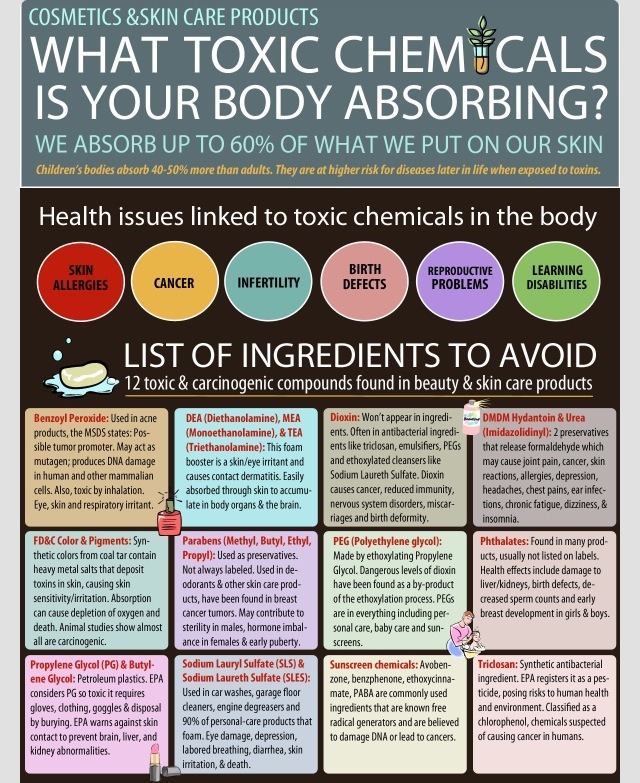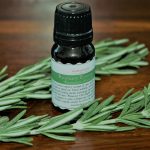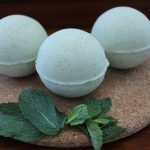List of Commonly Used Harmful Chemicals in Hair and Skin Care Products
Dont forget! Always read the label ingredients from any kind of products you buy!
All packaged skincare come with ingredients label meant to provide you with the information necessary to know exactly what you’re putting on your skin. Understanding what’s in the product helps you make healthier choices and also makes it easy for you to compare the benefits of the content of different options. Example when is about a serum, ingredients are listed in order of their concentrations, the first five ingredients or so are typically the bulk of the formula and usually include glycerin (an excellent moisturizer). A healthy and natural choice is crucial throughout your lifetime and paying attention to ingredients labels is a good step toward improving your lifestyle.
Dont forget also! Approximately 60% of what we put on our skin is absorbed into our bloodstream.
Major 10 Harmful Chemicals in Cosmetics List to Avoid
1. SODIUM LAURYL/LAURETH SULFATE (SLS AND SLES)
Found in: just about anything that foams; shampoo, body wash, face wash, hand soap, toothpaste, bubble bath.
A foaming agent used to break down water in grease. It’s so powerful that it’s also used in concrete floor cleaners, engine degreasers, and car wash detergents. A well-known skin irritant, it is rapidly absorbed and retained in the eyes, brain, heart and liver, which may result in harmful long-term effects. It can slow healing, cause cataracts in adults, and prevent children’s eyes from developing properly, corrode hair follicles and impair ability to grow hair. These surfactants that can cause skin irritation or trigger allergies. SLES is often contaminated with formaldehyde releasing 1,4-dioxane, a byproduct of a petrochemical process called ethoxylation.
2. PETROLEUM/PARAFFIN/MINERAL OIL
Found in: baby oil, lip balm, lip stick, lip gloss, mascara, moisturizers, concealer, foundation, face powder, hair gel, body wash, eye shadow, paraffin treatments, petroleum jelly, and hair conditioner
A petrochemical pollutant derived from crude oil, found in an overwhelming number of products. It seals off the skin creating a barrier which feels slick, but doesn’t allow the skin to breath, which is essential for the proper functioning of this organ. Ultimately causes slowing down skin’s function and normal cell development, resulting in premature aging and many other health and skin disorders such as contact dermatitis.
3. FORMALDEHYDE
Found in: nail polish, shampoo, body wash, eyelash glue, and hair products, the Brazilian Blowout and other straightening treatments
You won’t find this listed as “formaldehyde” except perhaps in a few remaining brands of nail polish.
It hides behind ingredient names such as: quaternium-15, DMDM hydantoin, imidazolidinyl urea, diazolidinyl urea, sodium hydroxymethylglycinate, 2-bromo-2-nitropropane-1,3 diol (Bronopol), glyoxal and oxaldehyde.
Recognized by the EPA as a carcinogen, it’s linked to lung cancers, Hodgkin lymphoma and leukemia, and myeloid leukemia. It permeates through inhalation and can also cause eye, nose, and throat irritation; reproductive and developmental toxicity; asthma; neurologic and behavioral toxicity; and immunological toxicity. It’s banned for use in cosmetics in Sweden and Japan.
4. HYDROQUINONE
Found in: skin lightening creams
A skin lightening chemical that inhibits the production of melanin and is a linked to cancer, organ toxicity and skin irritation.
5. MERCURY (THIMEROSAL AND MERTHIOLATE)
Found in: ear and eye drops; may be used in mascara
Metallic element used as a preservative and antiseptic known to damage brain function.
6. PARABENS (ISOBUTYLPARABEN, BUTYLPARABEN, METHYLPARABEN, PROPYLPARABEN)
Found in: almost every type of personal care product
Parabens preservatives commonly used to prevent the growth of bacteria and mold. They can mimic the hormone estrogen disrupting the endocrine system, which is known to play a role in the development of breast cancers. Parabens can cause skin irritation and contact dermatitis and Rosacea in individuals with paraben allergies. Studies indicate that methylparaben applied on the skin reacts with UVB leading to increased skin aging and DNA damage. These chemicals are also endocrine disruptors and have been linked to fertility problems.
7. PHTHALATES (DBP, DEHP, DEP)
Found in: Found in: synthetic fragrance, nail polish, hairspray.
A class of plasticizing chemicals used to make products more pliable or to make fragrances stick to skin. Phthalates disrupt the endocrine system and may cause birth defects. They have been linked to damage of the kidneys, lungs, and liver, as well. (see also Synthetic Fragrances)
8. SYNTHETIC FRAGRANCE/PARFUM
Found in: almost any type of personal care product
The synthetic fragrances used in cosmetics can have as many as 200 ingredients. There is no way to know what the chemicals are because formulas are protected under federal law’s classification of trade secrets. On the label it will simply read “fragrance.” Some problems caused by these chemicals include including hormone disruption, headaches, dizziness, rash, hyperpigmentation, violent coughing, vomiting, skin irritation—the list goes on. Don’t buy a cosmetic that has the word “fragrance” on the ingredients label. Look for labels that say, “phthalate–free”.
9. PROPYLENE GLYCOL
Found in: cosmetics, baby wipes, lotion, toothpaste, shampoo, and deodorant
Propylene Glycol will cause serious health conditions, including liver and heart damage and damage to the central nervous system if sufficient is absorbed by the body. Used in anti-freeze solutions, in brake and hydraulic fluids, as a de-icer, and as a solvent. There is no difference between the propylene glycol used in industry and that used in personal care products. It has been known to cause allergic reactions, hives and eczema.
10. TRICLOSAN
Found in: antibacterial products such as soap, hand sanitizer, deodorants, toothpaste, and cosmetics
Studies have shown that triclosan is an endocrine disruptor and enables bacteria to become antibiotic-resistant. The CDC states that it is found in 75% of the population’s urine. The American Medical Association advises against the use of antibacterial soap at home to prevent the creation of antibiotic-resistant bacteria. Antibacterial soap has been found no more effective than regular soap. Antimicrobial pesticides toxic to the aquatic environment; may also impact human reproductive systems.
Alphabetical order of TOXIC INGREDIENTS IN COSMETICS TO BE AVOIDED
1
1, 4 Dioxane: Highly carcinogenic, irritates eyes and mucous membrane, skin, CNS depressant, nephrotoxin, hepatotoxin, irritation, liver and kidney damage, blood disorders. This is a contaminate usually found in another chemical so it does not get listed as an ingredient. Likely ingredients to be contaminated are: Sodium Laureth Sulfate(SLES) PEG compounds, Chemicals that include “xynol” “ceteareth” and “oleth”
A
Aluminum: Neurotoxicant, eye, skin & lung irritation, endocrine disruptor, linked to Alzheimers and breast cancer.
Ammonium Laureth Sulfate: Irritates skin, contaminant of water, may be contaminated with the carcinogen 1, 4 Dioxane
B
BA(Bisphenol) Hormone disruptor, obesity
Behentrimonium Chloride, Gurr Hydrosypropltrimonium Chloride, Linoleamidepropyl PG-Dimonium Chloride Phosphate Necrosis mucous membranes, toxic
Benzene: carcinogenic, not metabolized quickly, can cause DNA mutations. Usually only a trace amount and not normally listed in ingredients.
Benzyl Alcohol: strong neurotoxicant, may cause allergic reaction in lungs, cause: itching, burning, scaling, hives, blistering of skin, liver damage, coma & death in animals
Boric Acid: Banned in Japan and Canada. Reproductive toxin, strong endocrine disruptor, unsafe to use with infants or on injured or damaged skin, causes death, birth defects in animal testing.
Butylated Hydrotoulene (BHT) Endocrine disruptor, low doses toxic to skin and lungs, caused death, liver, stomach cancers, thrombosis, fibrosis, liver and brain damage in animals, strong skin and eye irritant
BPA hormone disruptor
Butylene Glycol: skin, lung, eye irritant, environmental toxin.
Butylparaben: irritates skin and eyes, disruptor to endocrine, linked to breast and ovarian cancer, environmental contaminant.
C
Chloracetamide: Banned in Canada! Strong skin, eye, lung irritant, if inhaled is toxic, causes paralysis, goiter, birth defects in animals.
Coal Tar: Banned in most countries including Canada and European Union; still used in anti-dandruff shampoos in U.S. and UK. Known human carcinogen, lung & urinary tract cancer, potent skin irritant, multiple cancers in animal studies.
Cocamide DEA: surfactant, an irritant, very drying to skin and hair. derived from coconut, industrially chemically processed into a synthetic, no longer a natural ingredient. Combines with other chemicals to produce nitrosamines, carcinogen
Cocoamidopropyl Betaine CAPB: a surfactant created from processing coconut oil with petrochemical amines, dimethylaminopropylamine. Known for causing allergic or sensitized reaction, including irritated skin, rash. burning, itching and even blistering skin. This reaction is usually attributed to impurities that remain in the end product from the chemicals used in processing. This could be 3-dimethylaminopropylamine.
~Cocoamidopropyl Betaine has made our List of Harmful Chemicals in Cosmetics not because it is the most toxic, but because it is an example of how “Natural” products are being so misleading . Manufacturers are using synthetic ingredients “derived from” natural ingredients to show theirs is a natural product. When that is not true if they are using ingredients like this. This “Greenwashing” is becoming more common as more people look for natural products. Manufacturers want to profit from the natural market without making natural products. Ingredients like this usually come with (coconut derived) or (from coconut) or similar. This is NOT a natural ingredient.
D
DEA(Diethanolamine)(MEA&TEA included): Detergent, solvent, carcinogen. Damage in Liver, kidneys and pancreas. Health risk to children, linked to miscarriage and detrimental to developing brain & teratogen. Found in over 600 personal care products. Easily absorbed through skin, carcinogen, hormone disruptor, affects fetal brain development. Significant cumulative toxicity. Damage to spleen, liver, kidneys, pancreas, nerve damage to brain and spinal cord. Mounting tissue and eye problems. Nerve damage, premature death. Animal testing shows cancer when applied to skin
Dibutyl Plthalate: Neurotoxicant, linked to impaired fertility and urinary abnormalities, breast and ovarian cancers, contaminates wildlife.
Dioxins found in the fats of animals. Cause Cancer, reproductive disordersk skin toxicant, endocrine disruptor
DMDM Hydantoin: contains carcinogenic Formaldehyde, skin eye and lung irritant, environmental toxin.
E
EDTA Toxic to: respiratory tract, eyes, skin, kidney damage, Toxic to: reproductive effects, fertility, post implantation, mortality, mutagenicity,morphological changes in chromosomestructure of plant and animal cells, , FETAL EFFECTS embryo or fetus, stunted fetus, developemental abnormalities, cardiovascular, mortality, Ecological and environmental soil perversion, marine life, aquatic organisms, leaches through soil into groundwater
F
Formaldehyde: Banned in Canada and Japan. Determined to be safe for use in cosmetics in U.S. May or may not be listed in ingredient. Known human carcinogen linked to leukemia, pancreatic, skin, liver and lung cancer.irritant of: skin, eye, lung, liver(causes cirrhosis), stomach kidneys and bladder. Can burn skin, trigger asthma, hazardous air pollutant, environmental toxin.
Formalin(Formaldehyde Solution): Banned in Canada and European Union linked to Leukemia, nasal and nasopharyngeal cancer, neurotoxin in humans and animals, linked to badder and liver cancer.
H
Hexylene Glycol Toxicological data: oral, Dermal, Acute, Hazardous skin contact, eye, inhalation. Toxic kidneys, nervous system, liver. Sensitizer, Carcinogenic, Mutagenic, Teratogenic, Developemental Toxicity.. No Information Available/Data From MSDS
L
Lead acetate human reproductive system toxin, impair development
M
Mercury (thimerosal) eye drops, ointments, mascaras toxic human reproductive system, development
Mineral oil: petroleum by-product that coats the skin, clogging pores interfering with skins ability to eliminate toxins. Promote acne and other skin disorders.
P
Parabens: Found inside breast cancer tumors skin, eye irritant, endocrine disruptor, linked to breast & ovarian cancers, environmental contaminant. Endocrine disruptors, highly toxic, harmful if swallowed or inhaled. Allergic reactions skin rashes. immunotoxicity, neurotoxicity, hormone disruptor acts like estrogen in body. Parabens usually start with “methlyl” ” ethly” “propyl” and “Butyl”
Phthalates(AKA Fragrance, parfum): Never listed in ingredients) THIS IS A PENETRATION ENHANCER! emulsifier, carrier for synthetic fragrance. 2008 president Bush signed a ban on phthlalates in childrens toys but is still used in children’s bath products.Hormone and Endocrine disruptor, reproductive and organ toxin, neurotoxicant, impaired infertility, obesity, respiratory toxin, allergies, Kidney & liver damage. It is a genotoxic, teratogenic in animals, causes changes in organs and enzyme systems in humans. Reproductive and organ toxicity.
***This is a potential to cause harm and negative effects on early development***
**Targets males in utero and after birth.**
Polyethylene (Micro Beads) used in face/ body wash as abrasive exfoliators. Contain poisonious chemicals PCB (polychlorinated biphenyls) and insecticide DDT. Carcinogens. Accumulative. Micro plastics absorb pollutants, organisms mistake them for food and eat them ending up in the food chain. Too small to be removed by water treatment plants filtration systems, they are carried by drains to larger bodies of water. Great Lakes testing contained 6000,000 micro beads per square kilometer. Major water pollutant, disruptive and toxin to wildlife and aquatic animals.
PPD, p-phenylenediamine thought to be a mutagen, cause genetic mutations
Propylene Glycol(propanediol, methylethylene glycol, methylethyl glycol, 1, 2-dihydroxypropane, etc.) Carries chemicals directly into bloodstream!! Ingredient in most baby products moist/baby wipes, make-up, moisturizers, shampoo & conditioners!!skin irritant, kidney damage, liver abnormalities. GI distress, nausea, headache, vomiting, CNS depression, contact dermatitis,strong skin toxin, seizure, cardiopulmonary, MSDS sheets advise to avoid skin contact as may cause liver abnormalities and kidney damage.
Some Manufacturers of Natural Products are trying to appeal to the consumer of the Natural Market without giving up the harsh, toxic and cheap chemicals they want to use. Exchanging cheap and harmful for safe, natural requires using more expensive chemicals and that cuts profits. They are attempting to mislead the consumer, labeling the same ingredients with such things as :(derived from glycerin/coconut/palm oil), (Natural Sources)(corn),( vegetable derived )or( natural gas) The “drived from” makes no difference. It is Propylene glycol no matter what it began as. Whether it came from vegetable oil or natural gas, it has the same effect in the product and to you.
S
Sodium Lauryl Sulfate(SLS)/ Sodium Laureth Sulfate (SLES): a surfactant, which is a foaming agent, found in almost every shampoo on the market and many detergents, soaps and even toothpaste! Not only commercial products but it is sold to many smaller makers also.If it “foams up” then there is a good chance it contains either of these two chemicals, check the label. In large enough doses, it capable of changing information of genetic material found in cells, breaking skin’s structure. In studies it has been used to induce mutations in bacteria, denatures proteins,. “…concentrations of SLS as low as 0.5% could cause irritation and concentrations of 10-30% caused skin corrosion and severe irritation” ~Journal of The American College of Toxicology 1983. Although SLS is used in so many shampoos that have foamy bubbles, it is damaging to hair follicle, it will corrode hair follicles and damage the follicle enough to be unable to grow hair back. Permanent damage and corrode skin, hair follicle, skin toxin. Damage skin and permanently damage formation of a child’s eyes, and even cause liver toxicity. SLES is less irritating but is unable to be metabolized, building up over time.Mutagen, breaking skin structure, carcinogen,
T
Toluene: used for hair conditioners, long term use will cause hair to become dry and brittle, irritant, allergenic, toxic. Taken orally can be lethal
~Fragrance~
Fragrance oil/Fragrance:
- When this is listed as an ingredient on an “All Natural” product, you might be inclined to believe the fragrance is from a natural source.
- FDA allows that the chemicals under “fragrance” are considered a trade secret and undisclosed.
- Unfortunately, that means that we don’t have a right to know what we are being exposed to.
- “Fragrance” can mean any number of chemicals, synthetic or natural.
- There are over 3500 materials approved for use in fragrance oils and are NOT policed by the FDA. Instead, the are self-regulated. Yikes!
- Fragrance oils are either wholly synthetic chemicals or contain synthetic chemicals.
- This can include the infamous: phthalates, Synthetic musks, ethylene oxide, and many dangerous others.
- These have such risks are hormone disruption, neurotoxins, sensitizers. It is being advised, over and over, to avoid anything that lists “fragrance” as an ingredient.
- Instead opt for fragrance free or naturally scented with essential oil or others nature produced.
~Flavor~
Flavor oil/ Flavor Fragrance:
- are made to taste/smell. Usually to resemble a natural flavor.
- These are made by enhancing a fragrance oil with either a flavor or sweetener.
- Fragrance oils are synthetic.
- Starting with a synthetic, you add more synthetic.
- Flavor fragrances are IFRA(International FRagrance Association) approved for contact with lips and are produced using GRAS(GENERALLY Recognized As Safe).



